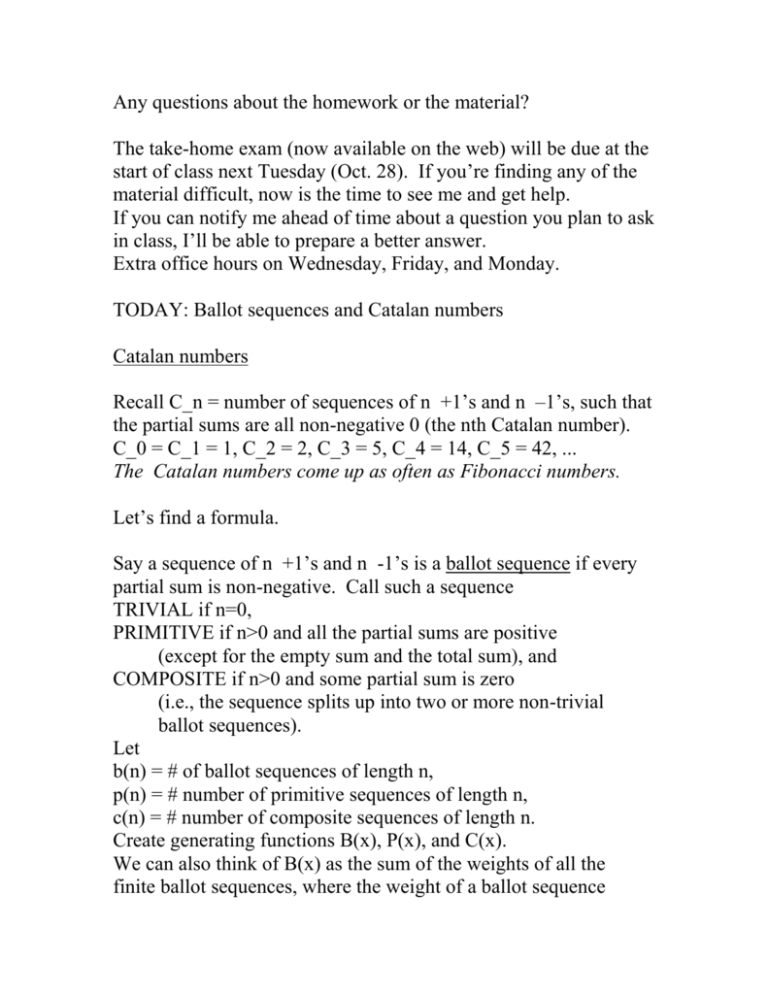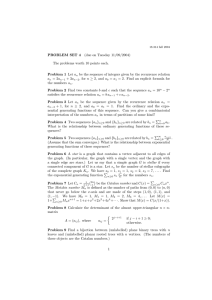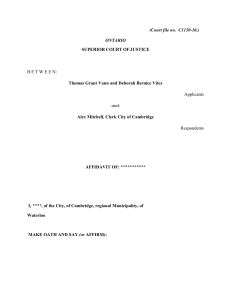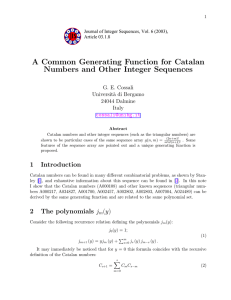Formal power series
advertisement

Any questions about the homework or the material?
The take-home exam (now available on the web) will be due at the
start of class next Tuesday (Oct. 28). If you’re finding any of the
material difficult, now is the time to see me and get help.
If you can notify me ahead of time about a question you plan to ask
in class, I’ll be able to prepare a better answer.
Extra office hours on Wednesday, Friday, and Monday.
TODAY: Ballot sequences and Catalan numbers
Catalan numbers
Recall C_n = number of sequences of n +1’s and n –1’s, such that
the partial sums are all non-negative 0 (the nth Catalan number).
C_0 = C_1 = 1, C_2 = 2, C_3 = 5, C_4 = 14, C_5 = 42, ...
The Catalan numbers come up as often as Fibonacci numbers.
Let’s find a formula.
Say a sequence of n +1’s and n -1’s is a ballot sequence if every
partial sum is non-negative. Call such a sequence
TRIVIAL if n=0,
PRIMITIVE if n>0 and all the partial sums are positive
(except for the empty sum and the total sum), and
COMPOSITE if n>0 and some partial sum is zero
(i.e., the sequence splits up into two or more non-trivial
ballot sequences).
Let
b(n) = # of ballot sequences of length n,
p(n) = # number of primitive sequences of length n,
c(n) = # number of composite sequences of length n.
Create generating functions B(x), P(x), and C(x).
We can also think of B(x) as the sum of the weights of all the
finite ballot sequences, where the weight of a ballot sequence
is defined as … x to the power of … half of its length.
We have
B(x) = 1 + P(x) + C(x)
(here 1 = 1x^0 is for trivial the ballot sequence).
C(x) = … B(x) B(x) ? No.
By the multiplication principle,
C(x) = P(x)^2 + P(x)^3 + … = P(x)/(1–P(x))
Third equation? ...
P(x) = x B(x)
because a primitive sequence consists of a +1, followed by an
arbitrary ballot sequence, followed by a –1.
Combining the equations, we get
B(x) = 1 + P(x) + C(x)
= 1 + P(x) + [P(x)]^2 + [P(x)]^3 + …
= 1/(1 – P(x))
= 1/(1 – xB(x))
So (1 – xB(x)) B(x) = 1, and
_____________________
|
|
| x B(x)^2 – B(x) + 1 = 0 |
|_____________________|
Solve the boxed equation:
B(x) = (1 plus-or-minus sqrt(1-4x))/2x
= (1 plus-or-minus (1-2x-2x^2-4x^3-10x^4-...))/2x.
The plus-solution is not a power series at all; it’s a Laurent series
1/x – 1 – x – 2x^2 – ...
(and I don’t know of any combinatorial interpretation of this
spurious solution).
The other solution is
1 + x + 2x^2 + 5x^3 + ...
which is the one we want.
We find an explicit formula via the binomial theorem:
(1-4x)^(1/2) = sum_n (1/2 choose n) (-4)^n x^n
= sum_n [(1/2)(-1/2)(-3/2)...(-(2n-3)/2)/n!] (-1)^n 2^{2n} x^n
= sum_n [(1)(-1)(-3)...(-(2n-3))/n!] (-1)^n 2^n x^n
Digression: (1)(2)(3)(4)...(2n) = (2n)!
(2)(4)...(2n) = ... 2^n n!
(1)(3)...(2n-1) = (2n)! / (2^n n!)
So the coefficient of x^n in (1-4x)^(1/2) is
(2n)! / (2^n n!) divided by (2n-1) n!
times
(-1)^(n-1) (-1)^n 2^n;
that is, the coefficient is
– (2n)! / [n! n! (2n-1)] = – (2n choose n) / (2n-1).
So the coefficient of x^n in (1-sqrt(1-4x))/2x (for n > 1) is
the coefficient of x^{n+1} in (1-sqrt(1-4x))/2, which is
(1/2) (2(n+1) choose (n+1)) / (2n+1).
= (2n choose n) / (n+1).
Note that the generating function for the Catalan numbers is
algebraic.
Could it be rational generating function?
No:
Reason #1: You can use algebraic methods to show that no rational
function R(x) satisfies the boxed equation.
Reason #2: Stirling’s formula implies that the nth Catalan number
grows like 4^n n^{-1.5}. If the generating function were rational,
the exponent –1.5 would have to be a non-negative integer.
Catalan triangle:
1
1
1
1
1
1
4
3
2
1
5
14
9
5
2
28
14
5
42
14
42
Note diagonals: degree 0, degree 1, degree 2 (check!), ...
For an extra challenge, you might try to conjecture a formula for
the entries in this table (hint: each can be expressed as a difference
of two binomial coefficients).











